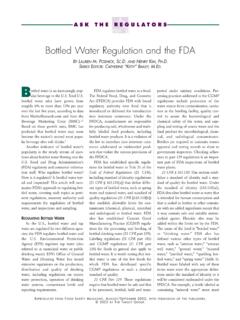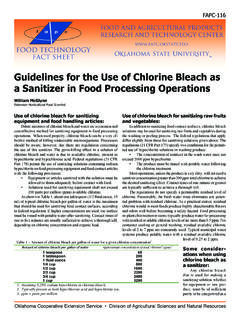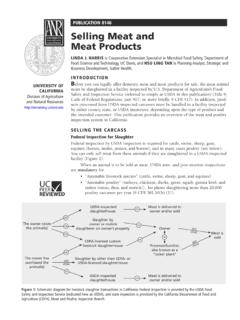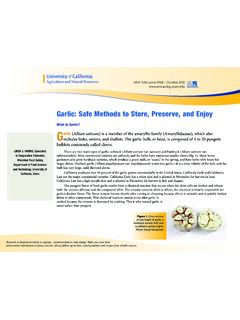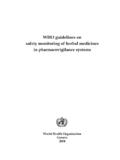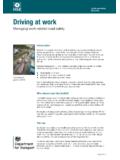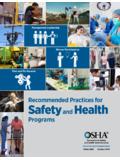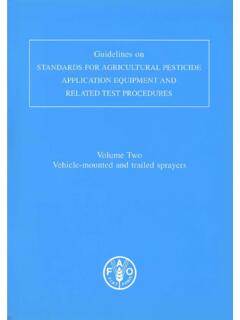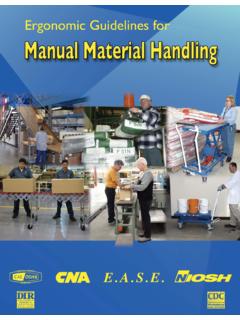Transcription of SALMONELLA CONTROL GUIDELINES COVER NOV.2010 - …
1 SALMONELLACONTROLGUIDELINESSALMONELLANOV EMBER 2010 Page 1 Foreword These SALMONELLA CONTROL GUIDELINES were prepared as an educational document for American Feed Industry Association (AFIA) member companies to provide suggested practices to minimize contamination of animal feed, ingredients and pet food products with the subject organism. It is the responsibility of all manufacturers of animal feed, ingredients and pet food to take the necessary steps to provide SALMONELLA -negative product. Thus, these GUIDELINES were written to promote SALMONELLA CONTROL at all animal feed, ingredient and pet food facilities. It is expected that these practices will also help reduce other bacteria populations of concern. The GUIDELINES are intended to update and replace a comparable set of recommendations prepared by AFIA in 1990, entitled Recommended SALMONELLA CONTROL GUIDELINES for Processors of Livestock and Poultry Feeds which replaced the 1970 recommendations by the Department of Agriculture (USDA) in cooperation with a group of three associations, which included the AFIA.
2 The original USDA recommendation, Recommended Sanitation GUIDELINES for Processors of Livestock and Poultry Feeds, was the third in a series of publications. Recommended Sanitation GUIDELINES for Processors of Poultry and Animal Byproducts, and in The Processing of Fish Products, were similarly developed by USDA in 1964 and 1965, respectively. CONTROL of SALMONELLA in feeds, ingredients and pet foods has been a long-standing objective of conscientious producers of ingredients and finished feeds and foods. That effort was materially assisted in both direction and effect with publication of the original GUIDELINES . It is hoped that this third generation of GUIDELINES for feed, ingredient and pet food processors will provide additional assistance in a continuing effort directed at controlling SALMONELLA utilizing the latest scientific principles and data. Personnel at each facility should determine if and how any or all of these suggested practices may apply to their operation.
3 Some suggestions may not be practical or applicable for a particular facility. These suggestions should be considered in the redesign of current facilities or the design of new facilities. This document is intended for industry guidance only, and it provides recommendations on how best to effectively CONTROL SALMONELLA in feed, feed ingredients and pet food. Comments and suggestions are welcome. Correspondence should be sent to the American Feed Industry Association, 2101 Wilson Blvd., Suite 916, Arlington, VA 22201, Page 2 SALMONELLA viewed under magnification. Introduction The old adage that understanding the problem is half the solution is applicable to CONTROL of SALMONELLA in animal food. Equally applicable is the general principle that a subject should first be defined before understanding can commence. SALMONELLA is the general name of a form of bacteria originally isolated in 1885 by Dr. Salmon, after whom it is named.
4 SALMONELLA are rod-shaped, gram-negative one-celled organisms that cannot be seen, smelled or tasted. In the SALMONELLA enterica group, there are more than 2,400 different serotypes or strains of the bacteria. SALMONELLA are ubiquitous in nature, being found just about anywhere one may look. They are common to the general environment. Of specific interest is the fact that they may be found on many raw foods, including those of oilseed and animal origin, on animals and humans, and in their gastro-intestinal tracts. Since ingestion of SALMONELLA may trigger illness generally referred to as salmonellosis, CONTROL procedures are called for to minimize the possibility of animal feed, ingredient and/or pet food contamination. Fortunately, the application of common sense to ingredient procurement, feed, ingredient and pet food processing and distribution, plus good housekeeping, can be most helpful in precluding problems associated with contamination.
5 In recent times, there has been an evolution in the use of nomenclature regarding the SALMONELLA genus. The common nomenclature is to use the genus SALMONELLA (in italics) and the serotype (ex. Enteritidis), which is understood to be SALMONELLA enterica (species) enterica (subspecies) Enteritidis (serotype). Thus, the serotypes are commonly stated as SALMONELLA Enteritidis or S. Enteritidis. The term CONTROL is used because of the nature of SALMONELLA and its widespread presence simply precludes elimination. This fact was recognized at a 1984 International Symposium on SALMONELLA , where a group of world-renowned scientists stated that .. the eradication of SALMONELLA in domestic animals is not attainable at this time .. Humphrey (2004) observed, Given its ubiquity, it is unlikely that SALMONELLA will be eradicated from the food chain. While eradication may not be possible, CONTROL is possible and should be exercised as a means of reducing or precluding contamination.
6 These GUIDELINES may be used to aid the efforts directed at achieving CONTROL of SALMONELLA . The goal of feed, ingredient and pet food processors should be to significantly reduce the incidence of SALMONELLA in all aspects of production. Page 3 SALMONELLA contamination will not normally be uniform within a lot of ingredients or mixed feed or pet food. Hence, an otherwise representative sample of the feed material may not actually be representative regarding the absence of SALMONELLA . This being the case, analytical results showing no SALMONELLA present are described as SALMONELLA negative, as tested rather than SALMONELLA free, as tested. By contrast, positive analytical results of properly secured and analyzed samples do indicate contamination. This important distinction should be kept in mind when interpreting analytical results. Domestic and foreign studies have reported the contamination of feed ingredients and manufactured feeds with SALMONELLA organisms.
7 Ingredients may be contaminated with SALMONELLA prior to being received at the processing facility. Such an ingredient may contaminate a relatively large quantity of mixed feed or pet food ingredient mix into which it is incorporated. Additionally, a single ingredient can contaminate processing equipment and the general facility environment. Contaminated equipment, organic material build-up, and dust may, in turn, cause contamination of subsequent batches of feed. These GUIDELINES are designed not only for feed and pet food facilities, but for ingredient suppliers as well. Heat and chemical processing, including pelleting, extruding, rendering, baking and use of some chemical CONTROL compounds are currently known to be effective processing procedures normally performed by feed, ingredient or pet food processors that can significantly reduce SALMONELLA . Heat, length of heating time, moisture level of the product and pressure applied may be sufficient to kill the organisms.
8 However if there is an extremely high level of SALMONELLA contamination in the feed, ingredient or pet food, or the products are pelleted or extruded at a relatively low temperature, complete destruction would be unlikely. Technology advances will likely provide additional equivalent SALMONELLA reduction procedures that may be used in the future. This will be especially relevant for non-heat treated, meal-form animal feeds and ingredients. This publication presents recommended GUIDELINES for all manufacturers of feeds, ingredients or pet foods and outlines sound management and operating procedures designed to aid in significantly reducing the incidence of SALMONELLA in finished products. Emphasis is placed on selective purchasing with a documented supplier management program, Good Manufacturing Practices (GMPs), Hazard Analysis and Critical CONTROL Points (HACCP), prerequisite programs, and robust continuous improvement activities. In general, these CONTROL principles are applicable to the wide variety of facilities which range from relatively simple farm-type to large, sophisticated commercial operations.
9 The specific application will vary with the physical facilities and business of the individual firm. SALMONELLA mitigation programs based only on testing finished products cannot provide adequate assurance of safe manufacturing and distribution. Therefore, these GUIDELINES represent a comprehensive approach to SALMONELLA CONTROL , encompassing a number of opportunities to reduce the likelihood Page 4 of SALMONELLA contamination. Sero-typing of SALMONELLA and other Enterobacteriaceae by Pulsed Field Gel Electrophoresis (PFGE) will assist in trace-back and CONTROL steps. To secure maximum benefit from these GUIDELINES , employees must be trained in appropriate plant sanitation practices and GMPs, and alerted to the need for strict adherence to prescribed operating procedures. Key personnel should be trained as security or sanitation officers to ensure all aspects of the GUIDELINES are consistently and effectively utilized. Representative laboratory samples should be used to monitor the effectiveness of the program.
10 If laboratory testing of incoming ingredients or finished products discloses SALMONELLA contamination, appropriate measures must be taken. In addition to the specific best practices discussed, it is important to have appropriate documentation practices in place such that plant procedures, corrective actions, monitoring and verifying documentation, testing records, etc., are readily available to plant personnel and for review. This guide is not a substitution for daily due diligence and adherence to plant sanitation practices. Instead, it offers some options for reducing the likelihood of SALMONELLA contamination in plants and subsequent products. The guide does not propose to encompass all plant type of operations. It only offers principles and GUIDELINES for all plants to use in accomplishing the goal of SALMONELLA reduction. Page 5 Table of Contents Content Page Foreword.
